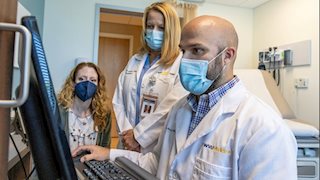Social media can impact youth mental health, self-image

MORGANTOWN, W.Va. – Social media has become a common part of our daily lives. It is a way to stay in touch with friends and family or connect with people who share common interests. However, the U.S. Surgeon General recently released an advisory cautioning against the negative impacts social media can have on children and adolescents.
The advisory details how frequency of use, the type of content consumed, and the types of interactions youth have can affect their mental health.
“The Surgeon General’s advisory has a lot of good information, and it is a really good example of using the psychological sciences to help inform policy as well as mental health more broadly,” Jonathan Perle, Ph.D., WVU Medicine pediatric psychologist, said. “It addresses the impact not just for America, but internationally as well.”

Perle said that the important takeaway from the statement is that social media is not inherently good or bad, but how it is used is the main concern.
“There are some very specific and unique benefits to social media,” Dr. Perle said. “Broadly speaking, it helps connect people. It helps build friendships, build common interests, and can help with building self-esteem and self-worth by finding others with your interests.”
“Social media helps underserved areas and individuals, especially those who are marginalized or unsupported and feel isolated. Some good examples of this are the LGBTQIA+ community and individuals with disabilities or rare conditions. It is easy to feel isolated when there aren’t others around you going through the same thing, so being able to talk to others going through the same thing can help children, or adults, not feel so isolated.”
The Surgeon General’s advisory and Perle agree that while there are positives to social media, children are often exposed to content that can be harmful, including violence, sexual content, self-harm, hate-based content, and misinformation.
“At this age, kids are very susceptible to peer pressure,” Perle said. “They’re very susceptible to images and when those images or messages are repeated, they can become normalized, and kids can see it as acceptable.”
“It is becoming harder and harder to tell what’s real between Photoshop, video editing, deep fake, and AI bots. This is most prevalent in reference to body dissatisfaction and disordered eating. The use of Photoshop and other image retouching apps creates unrealistic expectations and views.”
Cyberbullying and exposure to social media challenges, that are often dangerous, have become increasingly prevalent in recent years. Perle says that just the exposure to this content can increase rates of suicide and self-harm because children want to do what they think will help them fit in with their peers.
“Children and adolescents often seek social approval,” Perle said. “These kids want to be liked and they copy what they see influencers and content creators doing because they think that is what will help them become more popular. Research has shown that kids who are asked what they want to be when they grow up are saying they want to be YouTubers or TikTok stars instead of doctors or lawyers because they see it as a quick way to make money and, for all intents and purposes, for those who hit it big, it can be.”
Perle says the main thing parents can do is educate their children on how to use social media properly and how to protect themselves.
“Adult modeling is very important,” Perle said. “Content algorithms on social media sites use cookies to track the content that is consumed outside of social media, so if you’re going to more adult-oriented websites, you will see more of that content reflected in your social media. Kids are very savvy and know how to find ways around parental controls and algorithms are getting better at bypassing those controls as well. This is why it is so important to talk to children about how this content can affect them and what to avoid.”
From a scientific standpoint, there is limited long-term research on how social media can affect children and adults because social media is still relatively new. Many studies have relied on anecdotal evidence to show trends related to social media use.
“At this point, we have well over a decade of good research on social media, but the problem is that it is still in its infancy relative to other subjects because social media is still a relatively new idea,” Perle said. “The problem is, we still need better research on the pathways to both the issues and the benefits of social media use.”
“Social media is not inherently good or bad. When it comes to adolescents, proper education, monitoring, and a parental safety net can make a significant difference. These kids are not at a developmental level to understand that the content they are seeing can be dangerous. I think we need to be more solution-focused because kids are going to find information if they want it. It is more important that parents help build their child’s self-confidence to help them manage these situations and increase their comfort in talking to either a parent or another adult if they have questions about things they see online.”



